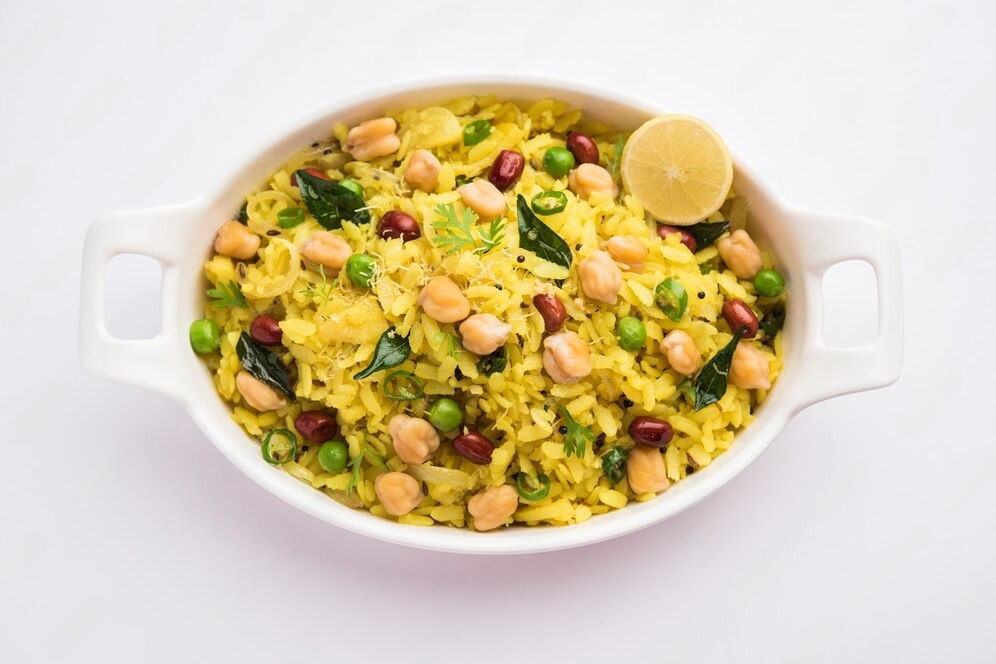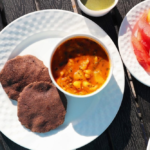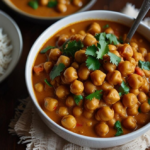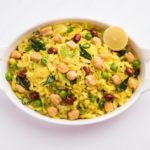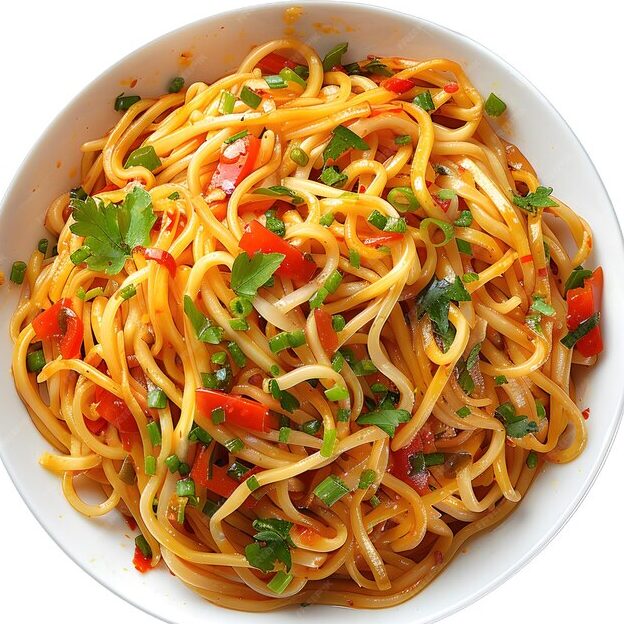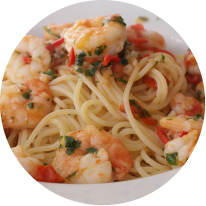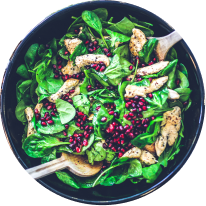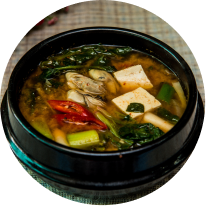Introduction
Indian cuisine offers a range of delicious and easy-to-make breakfast options, and Masala Poha (flattened rice) is undoubtedly one of the most popular. This vibrant, spicy, and healthy dish hails from the western regions of India, especially Maharashtra and Gujarat. Still, it has gained widespread popularity across the country due to its simplicity, taste, and nutritional benefits.
In this blog post, I will guide you through an easy Masala Poha recipe while also explaining its health benefits, customisation tips, and the cultural significance behind it. Whether you are a beginner in the kitchen or an experienced cook looking for a quick yet wholesome breakfast recipe, Masala Poha is an ideal choice.
What is Poha?
Poha, also known as “flattened rice” or “beaten rice,” is made from parboiled rice that has been flattened and dried. It has a soft, fluffy texture when moistened and absorbs flavours well, making it a versatile base for different dishes. In various parts of India, poha is prepared in numerous ways, and the addition of spices, vegetables, and herbs can elevate this dish into a savoury meal that bursts with flavour.
Masala Poha takes this staple a step further by infusing it with aromatic spices and fresh veggies, turning it into a filling and flavorful breakfast option or snack.
Ingredients
Here’s what you need to make a delicious bowl of Masala Poha:
Main Ingredients:
– 2 cups thick poha (flattened rice)
– 1 medium-sized onion, finely chopped
– 1 small potato, diced
– 1 medium tomato, chopped
– 1 green chilli, chopped (adjust according to your spice preference)
– 1 tsp mustard seeds
– 1 tsp cumin seeds
– 8-10 curry leaves
– ¼ tsp turmeric powder
– Salt to taste
– 1 tbsp oil (preferably peanut oil or sunflower oil)
– 1 tbsp peanuts (optional but adds a nice crunch)
– Fresh coriander leaves, chopped (for garnish)
– Juice of half a lemon
Optional Ingredients:
– A handful of frozen peas
– Grated coconut for garnish
– A pinch of sugar (for a slight sweetness, common in Gujarati-style poha)
– Sev (crunchy chickpea noodles) for garnish
Step-by-Step Masala Poha Recipe
Step 1: Prep the Poha
Begin by washing the poha thoroughly in a colander under running water for 15-20 seconds. This helps soften the flattened rice. Drain well and let it sit for about 5 minutes to ensure all excess water is removed. Sprinkle a pinch of salt and turmeric powder over the poha and mix gently.
Step 2: Roast the Peanuts (Optional)
In a pan, heat one tablespoon of oil on medium heat. Once hot, add the peanuts and roast until they turn golden brown and crunchy. Remove and set aside.
Step 3: Temper the Spices
Using the same pan, add the mustard seeds. As they start to splutter, add cumin seeds, followed by curry leaves and chopped green chillies. Sauté this aromatic mixture for a minute.
Step 4: Cook the Vegetables
Next, add the finely chopped onions to the pan and sauté until they turn translucent. Add the diced potatoes and cook them until they are soft and golden. You can cover the pan to speed up this process. If you’re adding peas, toss them in at this stage and cook for a few minutes.
Step 5: Add Tomatoes and Seasoning
Once the potatoes are cooked, add the chopped tomatoes and cook until they soften and integrate into the mixture. Season with salt and turmeric powder, and stir well.
Step 6: Add the Poha
Now, add the washed poha to the pan. Gently mix it with the vegetable-spice mixture, making sure not to mash the poha. Cook on a low flame for 2-3 minutes, allowing the flavours to blend nicely.
Step 7: Final Touches
Turn off the heat and sprinkle the roasted peanuts over the poha. Squeeze fresh lemon juice and garnish with chopped coriander leaves. If you prefer, you can also add a pinch of sugar or sev for extra crunch.
Step 8: Serve Hot
Your Masala Poha is ready to be served! Enjoy it hot with a side of chai or a glass of buttermilk for the perfect breakfast or light snack.
Health Benefits of Masala Poha
Poha is a wholesome and nutritious food, perfect for those seeking a healthy breakfast or snack. Here’s why it should be a regular part of your diet:
- Rich in Iron: Poha is a good source of iron, which is essential for maintaining healthy blood cells and preventing anaemia. Regular consumption of poha helps meet your body’s iron needs, especially when paired with a source of vitamin C like lemon juice to enhance absorption.
- Low in Calories: A serving of Masala Poha is relatively low in calories, making it ideal for those trying to maintain or lose weight. The dish is filling yet light on the stomach.
- Good Source of Carbohydrates: Poha provides energy due to its high carbohydrate content, which is crucial for powering through a busy day. Unlike heavy breakfast options, poha gives you sustained energy without feeling too heavy.
- Gluten-Free: Poha is naturally gluten-free, making it a great option for people with gluten intolerance or celiac disease.
- Rich in Fiber: The addition of vegetables like onions, tomatoes, and potatoes adds fibre, aiding in digestion and keeping you fuller for longer.
Customisation and Variations
One of the best aspects of Masala Poha is its flexibility. You can easily customize the recipe according to your taste preferences or the ingredients you have on hand. Here are a few ideas to change things up:
- Add Protein: For a higher protein content, you can add boiled chickpeas, paneer cubes, or scrambled eggs to your poha.
- Use Different Vegetables: Feel free to experiment with seasonal vegetables like bell peppers, carrots, or zucchini to add variety and colour to your poha.
- Spice Level: You can adjust the spiciness of the dish by adding more or fewer chillies. If you prefer a mild version, you can omit the green chillies altogether and rely on the other spices for flavour.
- Kanda Poha: If you prefer a simpler version, try the Maharashtrian favourite “Kanda Poha,” where onions are the star ingredient. You can skip the tomatoes and potatoes and focus on creating a flavorful dish with just poha, onions, and spices.
Cultural Significance of Poha
Poha is much more than just a breakfast dish; it holds a special place in Indian households, particularly in the western states. In Maharashtra, poha is served during social gatherings or as a humble yet hearty offering for guests. It’s also commonly prepared during festivals and special occasions. Gujarati cuisine often incorporates a slight sweetness into the poha, which pairs well with its savoury taste.
In northern India, variations like “Indori Poha” are popular, which is often garnished with sev, chopped onions, and pomegranate seeds, adding a burst of flavour and texture to the dish.
Conclusion
Masala Poha is an easy, healthy, and delicious breakfast that fits into even the busiest of mornings. Its versatility means you can adjust it according to your preferences while ensuring that it remains a nutritious meal. Whether you’re a student, a working professional, or a homemaker, this recipe will become a staple in your breakfast repertoire. So, next time you’re looking for something quick, tasty, and wholesome to eat, give this Masala Poha recipe a try!
View more Recipe:- LUCKNOW REMIX



